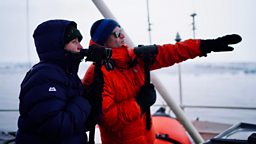Capturing the secret lives of pack ice killer whales
By Helen Hobin (Cinematographer)

Behind me, I hear a rush of breath—the sound of a killer whale expelling air from their blowhole. I can’t turn around to look. I’m holding onto a metal crane, on the other end of which is a long-lens camera in a gyro-stabilised housing, which hovers inches above the icy water of the Southern Ocean.
...eye contact with one of the most complex and intelligent mammals on the planet...
Another killer whale passes under our boat, and slowly rises to spy-hop the tiny zodiac. Making eye contact with one of the most complex and intelligent mammals on the planet, I feel utter exhilaration.
Our small team of scientists and filmmakers has travelled for weeks to be in this position, able at last to observe and record the behaviour of the pack ice killer whales known as B1s. And finally, after days spent lurching across the infamously rough waters of the Drake Passage, we can begin our work in earnest.

Director of Photography Tom Walker has experience in filming this rare ecotype of killer whale. In fact, watching their remarkable hunting techniques in the original ‘Frozen Planet’ series is what inspired him to leave his job as a postman, to pursue wildlife filmmaking in earnest.
...I鈥檓 struck by the parallels between their team and ours.
As the pair move away, continuing their search for seals at rest on the pack ice, he talks to our skipper Dave, better known as ‘Earl Grey’ for his continuous consumption of tea. Dave manoeuvres our RIB through the constantly shifting jigsaw of ice, following the apex predators at a respectful distance.
For me this expedition is a completely new experience. It is my first time in the Antarctic Peninsula, and with every change of light the landscape seems to reinvent itself. As the killer whales swim together, I’m struck by the parallels between their team and ours.

Crammed into a small working space, we too must rely on communication and collaboration. Tom calls out calm, concise instructions, and I focus on keeping our camera low for an immersive perspective, whilst avoiding the moving chunks of pack ice and the roll of the waves.
...we too must rely on communication and collaboration.
Above us, cinematographer Sam Stewart uses a drone to maintain an aerial view of the action. Whilst we employ Bluetooth headsets, below us clicks and whistles are used to communicate. In the excitement of filming, it’s easy to forget the long hours of searching and the ever-present fatigue of living and working in 24-hour daylight.
Scientists Dr Leigh Hickmott and Jessica Farrer have been generous in sharing their knowledge. Standing atop our 26-metre boat, I’ve spent day after day using Leigh’s scanning techniques and pivoting around the monopod on which my binoculars rest. The repetition of the arc, and the quick reset to the start position, remind me of the ‘ping’ of a typewriter.

Marine biologist Jess has taught me to distinguish different species of seal from afar using the outline of their body shape. Although the more docile Weddell seals are favoured prey, the female killer whale we watch now, known as Marge, and her calf Tickle, have begun spy-hopping a sharp-toothed leopard seal.
...we wait to see if they will risk taking on such an intimidating quarry.
With bated breath, we wait to see if they will risk taking on such an intimidating quarry. To our amazement, they seem to have called for back-up, and as four more pack ice killer whales appear, the demonstration of their incredible wave-washing skills finally begins.
Tom is operating the stabilised camera and must keep his eyes on the monitor. Earl Grey and I quietly call out the positions and actions of the killer whales, as we manoeuvre boat and jib: “Three o’clock. Wave.”

Leopard seal vs. killer whales
A fierce predator faces pack ice killer whales in a breathtaking Antarctic showdown.
Sitting so low to the water in the zodiac, the size and speed of the waves are even greater than I imagined. But it’s the complexity of the communication which strikes me, and the moments in between the action of the hunt. The nuzzling, the tenderness, the care for the young.
...the size and speed of the waves are even greater than I imagined.
Leigh has a directional hydrophone system, which features a kitchen wok as the parabolic dish. If he can get audio recordings of this behaviour, perhaps we can understand more of the family dynamics behind the masterful techniques.
As the expedition goes on, the challenges of finding these killer whales, let alone filming them, only seem to grow. We pass through open water, showing no sign of the expected pack ice on which seals haul out. The boat is rocked by storms and bad weather.

Each glimpse we get into the dynamics of pack ice killer whales allows us to better understand the care with which these families are being raised—how their skills are passed on and their lives affected in such a rapidly changing world.
We wait, watching for the thrill of a dorsal fin breaking the dark water.
As we travel onwards, Leigh is looking for a particular black and white matriarch in this monochrome kingdom.
We wait, watching for the thrill of a dorsal fin breaking the dark water.
